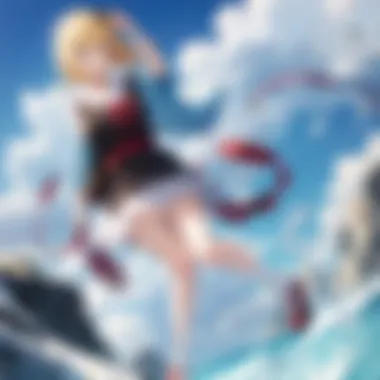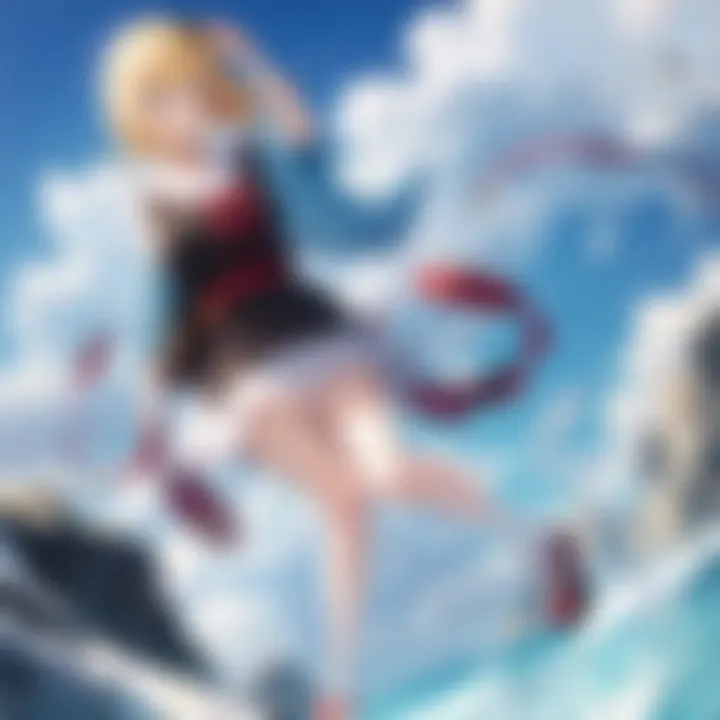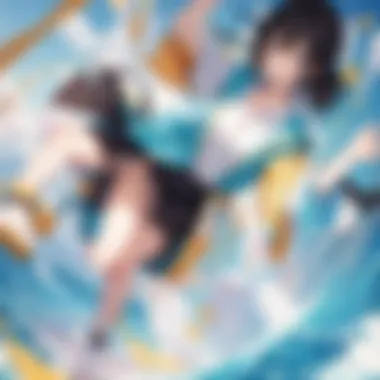Exploring Happiness in Manga: Insights and Reflections


Intro
Happiness is a complex emotion. It affects the way we view ourselves, our relationships, and even how we navigate through life's challenges. In manga, this theme is particularly fascinating. This medium captures the essence of happiness through diverse narratives. The characters and their journeys offer insight into personal and cultural perspectives on joy. In this article, we will explore how different manga series portray happiness.
Through detailed character analysis and thematic exploration, readers will understand how manga reflects real-life emotions and experiences. Furthermore, we can observe how cultural backgrounds shape these representations and influence audience reactions. A deeper examination reveals the significance of these narratives within the broader context of mental well-being and personal fulfillment.
Character Profiles
Overview of Main Characters
Manga features a range of characters, each with unique backgrounds and perspectives on happiness. Main characters often serve as the lens through which we explore themes of joy. They may experience a journey from struggle to fulfillment, illustrating how happiness is achieved or lost.
For example, in My Neighbor Totoro, Satsuki and Mei are the youthful figures who find joy in simple moments. Their innocence and the magic of childhood highlight a pure form of happiness that resonates with many readers.
Supporting Characters
Supporting characters enrich the story, adding layers to the main characters' understanding of happiness. These characters can either serve as obstacles or sources of wisdom, guiding the protagonists through their challenges. In Fruits Basket, for instance, the Sohma family members embody complexities of happiness and trauma, influencing Tohru Honda’s journey toward joy.
Theme Exploration
Central Themes
Happiness in manga encompasses various narratives, from slice-of-life stories to fantasy adventures. Central themes often include the pursuit of dreams, the value of friendship, and the importance of self-acceptance. These elements show that happiness is not a constant state but a journey filled with ups and downs.
Cultural References
Cultural context plays a vital role in how happiness is portrayed in manga. Japanese culture often emphasizes community, harmony, and relationships. For instance, a series like March Comes in Like a Lion uses Shogi as a metaphor, showing how personal struggles and victories contribute to one's happiness. This perspective can lead readers to reflect on their cultural backgrounds and how they shape their definitions of joy.
Popular Series and Recommendations
Top Anime Series of the Year
Some manga series have gained critical acclaim for their exploration of happiness. Titles like Attack on Titan and Spy x Family offer engaging narratives that balance emotional depth with character development. Readers often find themselves reflecting on their own lives through these stories.
Hidden Gems in Manga
There are lesser-known series that also deserve attention.
- Natsume's Book of Friends explores the connections between humans and spirits, focusing on understanding and compassion.
- Yona of the Dawn presents a princess's journey, emphasizing personal growth and happiness.
Understanding Happiness in the Context of Manga
The exploration of happiness in manga is a rich field that touches on numerous dimensions of human experience. Happiness in manga is not just a background theme. It represents cultural values, psychological conditions, and societal expectations. By examining happiness, one gains insight into character motivations, plot developments, and even the audience's emotional responses.
Focusing on happiness within this medium offers several benefits. One key element is understanding how different genres portray happiness. For instance, slice-of-life manga often highlights ordinary moments that bring joy, while shonen manga may show happiness as a result of overcoming challenges.
Moreover, analyzing these narratives helps in recognizing the cultural influences that shape how happiness is depicted. Different societies view happiness through various lenses—what brings joy in Japan may differ from other cultures. Recognizing these variances can lead to a deeper appreciation of the stories and characters in manga.
Furthermore, the exploration of happiness goes beyond mere representation. It also reveals the psychological impacts these stories may have on readers. How do these depictions influence perceptions of personal happiness? How might they contribute to emotional well-being? Understanding these questions is crucial to appreciating the medium and its artistry.
"The true value of happiness in manga lies in its ability to resonate with readers on multiple levels, informing not just what makes characters happy, but what might make us happy too."
As the narrative unfolds, one can engage with these themes critically, opening a dialogue about the ways happiness is constructed in manga. This critical lens enhances the reading experience, making it not just about entertainment but also about understanding life itself.
Defining Happiness Within Manga Narratives
Happiness in manga takes various forms, often influenced by character backgrounds and story arcs. It often manifests in contrasting ways depending on the narrative context. For example, some characters might experience fleeting moments of joy, while others attain happiness as a long-term goal. This variance in definition provides a broader understanding of happiness itself, encouraging readers to reflect on their emotions and experiences.
The depiction of happiness also plays a critical role in character development. Characters may start with despair or dissatisfaction, and throughout their journey, they may discover what true happiness means to them. This evolutionary aspect of happiness reflects a realistic portrayal of life's complexity.
Cultural Influences on Happiness Depictions
Cultural contexts greatly influence how happiness is portrayed in manga. In Japanese culture, there is a strong emphasis on community and relationships. This emphasis can shape stories that highlight collective joy rather than individualistic happiness. Notably, manga intended for younger audiences might focus on friendships and shared adventures, while stories aimed at older demographics may explore more existential themes surrounding happiness.
Different eras of manga also represent changing cultural views on happiness. Historical events in Japan, such as economic fluctuations or social changes, impact how happiness is represented. For instance, post-war manga often reflected themes of rebuilding and hope, while contemporary works may encapsulate a mix of nostalgia and modernity.
By considering these cultural influences, readers can understand better how happiness is more than a surface-level emotion—it is deeply intertwined with societal norms and collective experiences.
The Evolution of Happiness in Manga
The evolution of happiness in manga is a significant theme that provides insights into the changing cultural and societal dynamics within Japan. As various manga genres have emerged, the portrayal of happiness has also shifted, reflecting broader societal developments and historical contexts. Understanding this evolution allows readers and scholars alike to dissect how sentiments of joy and fulfillment are conveyed in visual narratives, and it also opens up discussions on how these narratives resonate with audiences from different backgrounds. Moreover, it highlights the capacity of manga to mirror the emotional landscapes of society.
Historical Perspectives on Happiness Themes
Historically, manga has been intertwined with Japan’s social fabric. In the earlier years of manga, during the post-war period, happiness was often depicted as a response to trauma and hardship. Manga narratives, such as those by Osamu Tezuka, commonly included themes of resilience, where joy was cherished against a backdrop of struggle.
Over the decades, as Japan experienced economic booms and crises, the depiction of happiness began to evolve. The portrayal of joyous moments transformed from mere escapism into a more nuanced representation of daily life. The works from the 1980s and 1990s, particularly in shōjo and shōnen manga, started to show more varied emotional experiences, moving beyond superficial happiness to explore deeper connections and interactions within relationships.


Happiness in manga became complex, often paralleling the struggles of adult life. As characters faced conflicts, their paths to happiness reflected societal expectations and personal desires. Thus, manga began serving as a reflective tool, providing commentary on what it means to be content in an ever-changing world. Readers could find not just escapism, but also a mirror to their evolving identities and values.
Changing Societal Values and Their Representation
The societal values influencing happiness themes in manga are not static. They evolve in response to Japan's socio-economic shifts, particularly in the late 20th and early 21st centuries. The shift from a collectivist to a more individualistic culture brought new dimensions to how happiness is represented. Manga began to reflect themes of self-fulfillment and individuality. In series like My Hero Academia, the pursuit of happiness is illustrated through personal growth and achieving one's dreams in a competitive world.
Additionally, issues such as mental health and emotional well-being became more prominent and complex in narratives. Manga creators became more attuned to the struggles of their readers, addressing feelings of anxiety and depression along with the pursuit of happiness. This led to a deeper exploration of happiness, often depicting it as an ongoing journey rather than a definitive state. By showing various characters navigating through their own challenges, manga has provided readers with diverse glimpses into the nature of joy, illustrating that happiness is multifaceted and often intertwined with both personal and societal struggles.
In summary, the evolution of happiness in manga reflects not just personal narratives but is deeply entrenched in cultural and societal contexts. It addresses the complexities of life and emotional experiences that resonate with audiences, enhancing their connection to the medium. As society continues to change, manga will likely continue to be a rich source for exploring the multifaceted nature of happiness.
Key Manga that Explore Happiness
The exploration of happiness within manga is not merely a thematic device; it serves as a vital lens through which readers can engage with complex emotions and realities of life. Manga series dedicated to this theme illuminate diverse facets of joy, fulfillment, and the quest for personal satisfaction. These narratives often resonate deeply with audiences, providing insights not only into characters’ lives but also reflecting societal values and struggles. By examining key works, we gain a richer understanding of how happiness is constructed and depicted, along with the potential effects on readers' perceptions and emotional well-being.
Slice of Life Manga: Everyday Joys
Slice of life manga specializes in portraying ordinary experiences and the small victories found in daily life. Series like "Yuru Camp" and "March Comes in Like a Lion" exemplify how these narratives effectively capture fleeting moments of happiness. Through depictions of friendship, personal growth, and leisure activities, slice of life often emphasizes the beauty in mundane routines.
Characters in these stories frequently face relatable challenges, showcasing how happiness can emerge from resilience and connection. For instance, the gentle pacing of these tales allows readers to reflect on their own lives, often sparking feelings of nostalgia and comfort. This genre promotes the idea that happiness does not always hinge on grand achievements. Rather, it often resides in the simplicity of everyday moments. A well-crafted slice of life manga can provide a therapeutic escape, offering reassurance that joy can be found even in life’s small, seemingly insignificant instances.
"Slice of life manga encourages readers to recognize and appreciate the small joys of life, fostering a more profound sense of fulfillment."
Adventure and Fulfillment in Fantasy Worlds
In contrast to slice of life manga, fantasy genres such as "One Piece" and "My Hero Academia" explore happiness through imaginative and often escapist narratives. Adventure tales transport readers into extraordinary worlds where characters embark on epic journeys, facing challenges that test their limits. The quest for personal goals, camaraderie, and triumph over adversity often intertwine with themes of happiness in these stories.
Characters typically strive for dreams that symbolize ultimate fulfillment, often facing trials that mirror real-life struggles. This exploration encourages a connection to the readers’ aspirations and desires. The worlds created in these narratives provide a backdrop where happiness can be intertwined with adventure, emphasizing how overcoming obstacles is integral to human experience. These tales often serve to inspire readers, demonstrating that pursuit of happiness can be a grand quest worth undertaking. This genre, therefore, reflects a unique blend of escapism and hope, underscoring the potential that lies in both happiness and personal achievement.
Psychological Impact of Happiness Depictions
The exploration of happiness within manga delves into its psychological implications on audiences and the emotional responses these narratives evoke. Happiness, as a theme, becomes a crucial aspect of character development and storytelling, making the reader introspect and connect with the character's journeys. Understanding the psychological impact reveals why these stories resonate deeply with readers, ultimately reflecting their own experiences and aspirations.
Emotional Responses to Manga Stories
Manga often portrays happiness through nuanced storytelling, allowing readers to respond emotionally. When characters experience joy, it evokes similar feelings in readers. The connection is not merely superficial; it dives into the core of human experience.
- Relatability: Readers often find themselves identifying with characters who experience joy or fulfillment. This relatability fosters a sense of community among readers.
- Catharsis: These narratives can act as a medium for catharsis. Readers, through the joy depicted, might find an escape from their own struggles.
- Emotional Validation: Happiness portrayed in manga validates readers’ feelings. This affirmation helps individuals cope with their own emotional challenges.
"The joy that is portrayed in manga can serve as both a refuge and an incentive for the reader’s own happiness."
The emotional responses can be further categorized:
- Joy: Direct happiness from scenes, often capturing life’s simple pleasures.
- Nostalgia: Reflecting on personal experiences when seeing characters enjoy similar moments.
- Sorrow: Feeling bittersweet empathy when happiness is disrupted.
Escapism and its Connection to Happiness
Manga is often considered a form of escapism. The journey through fictional realms provides a release from daily life pressures. This aspect connects strongly with themes of happiness that emerge in narratives.
- Temporary Relief: Readers escape into worlds where happiness can thrive. This temporary detachment allows them to rejuvenate emotionally.
- Exploration of Idealism: Through fantastical scenarios, readers witness idealized happiness. This can inspire them to pursue joy in their own lives.
- Safe Space for Reflection: Manga can provide a safe space for readers to reflect on their own happiness and desires.
By immersing themselves in these stories, readers often find a path to explore their own feelings about happiness. It encourages them to look for joy within their experiences, igniting a desire for a fulfilling life. The psychological impact of happiness in manga expands beyond entertainment; it builds a bridge to emotional understanding and personal growth.
Character Archetypes and Happiness
Character archetypes play a key role in the depiction of happiness in manga. They serve as a framework to convey complex emotions and messages. These archetypes allow readers to connect with characters on a personal level. Indeed, the projection of happiness often aligns with the development of these characters.
Understanding how these archetypes interact with the theme of happiness helps to illuminate the broader narrative structure. Characters such as the optimistic protagonist or the nurturing mentor typically embody ideals that the story seeks to explore. These roles provide tangible representations of happiness and its pursuit. They also reflect the diverse experiences and struggles that contribute to the human condition.
Through these archetypes, the manga explores different paths to happiness, emphasizing that it is often influenced by relationships and societal context. This exploration informs readers about various avenues for finding joy, and sometimes the path to happiness is fraught with challenges.
In engaging narratives, readers become invested in the characters' journeys. Their trials and triumphs often mirror real-life struggles, thus enhancing the emotional impact.
The Role of the Protagonist in Happiness Exploration
The protagonist typically serves as the central figure in happiness exploration. This character often embarks on a journey that leads them through various experiences aimed at discovering or achieving happiness. As a relatable anchor in the narrative, their development is crucial.
Protagonists can embody different responses to happiness—some may seek external validation or material success, while others may find joy in simple moments. Their choices reflect deeper philosophical questions about the nature of happiness.
For instance, in Kimi ni Todoke, Sawako Kuronuma navigates her social environment, seeking acceptance and friendship. Her journey represents the type of growth that is rooted in connections with others, emphasizing that happiness can be relational.
This focus on protagonists allows readers to analyze their own values and beliefs about happiness. Through their experiences, readers witness the consequences of various approaches to joy, from fulfillment through ambition to the importance of belonging.
Supporting Characters and Their Influence
Supporting characters are essential in shaping the narrative around happiness. They often highlight contrasting perspectives or serve as catalysts for change in the protagonist's journey. Their presence can bring depth to the exploration of happiness by revealing other aspects of life.
Characters such as friends, mentors, or even antagonists contribute to the protagonist's understanding of happiness. Their influence is multifaceted. For example, a mentor may help the protagonist realize their potential, leading to personal growth. Alternatively, an antagonist could challenge the protagonist's values, forcing a reevaluation of what happiness means.


Significant connections among characters often reveal profound insights into happiness. The dynamics of friendships, rivalries, and familial relationships reflect the complexities of human interaction.
For instance, in My Hero Academia, All Might serves as a beacon of hope and motivation for his students. His role emphasizes that happiness often stems from the support and guidance of others. This illustrates that the quest for happiness is rarely a solitary endeavor; instead, it relies on the collective impact of relationships within one's life.
Overall, both protagonists and supporting characters shape the narrative of happiness in manga. Their interactions create a rich tapestry of emotional experiences, reinforcing that the pursuit of joy is as much about connection as it is about individual fulfillment.
Artistic Techniques in Conveying Happiness
Artistic techniques play a crucial role in how happiness is depicted in manga. The blending of visual elements with storytelling forms a unique way to communicate emotions and experiences. In this regard, artists use specific methods to express joy, elation, or contentment, creating a resonant impact on the reader. The effectiveness of these techniques lies in their ability to transcend language and cultural barriers, communicating a universal feeling of happiness.
Many manga artists utilize visual symbolism to represent joy. The elements depicted in the artwork often serve as metaphors or direct representations of happiness. For instance, scenes featuring wide smiles, sparkling eyes, or open landscapes can invoke feelings of joy and freedom. Furthermore, background imagery, like blooming cherry blossoms, bright sunshine, or tranquil bodies of water, support the portrayal of happy moments. These symbols create an emotional connection between the characters and the readers, emphasizing the narrative's joyful aspects.
Visual Symbolism of Joy in Manga
Visual symbolism in manga plays an integral role in conveying happiness. Symbols such as flowers, sunshine, and open skies often evoke positive emotions. When characters are illustrated in a joyful state, the surrounding visual elements enhance this message. The use of exaggerated facial expressions, like wide grins or blushing cheeks, signals happiness immediately.
Moreover, certain colors are recurrently associated with joy. For example, bright colors like yellow and pink are prevalent in scenes depicting happiness. These choices create associations that help readers quickly identify positive emotions within the story. In essence, visual symbolism enriches the storytelling, allowing readers to grasp emotional nuances without requiring extensive dialogue.
Color Theory and Its Emotional Effects
Color theory significantly influences the portrayal of happiness in manga. Different colors evoke distinct emotional responses. Warm colors like red, orange, and yellow tend to promote feelings of warmth and happiness. These colors engage the reader’s emotions and create an inviting atmosphere. In contrast, cooler colors, like blue or green, might depict tranquility or melancholy.
The strategic use of color throughout a manga series can subtly shift a reader's perception of the narrative. For instance, during a happy scene, light and vibrant colors may dominate the panels. As the story takes a more serious turn, darker or cooler tones can signify the shift in emotions.
Understanding color theory allows artists not only to enrich their stories but also to amplify the emotional impact on readers. The interplay of color against the characters' actions and expressions can deepen the exploration of happiness, marking significant turning points in character development.
"Artistic choices in manga go beyond mere illustrations; they are the heartbeats of emotional narratives. The visual elements resonate at the core of human experiences, uniting readers in their understanding of happiness."
The Role of Happiness in Character Development
Happiness plays a critical role in character development within manga narratives. It becomes a driving force that propels characters through their arcs, influencing their decisions, relationships, and ultimately their growth. The exploration of happiness in character development allows for a deeper understanding of what it means to seek fulfillment and joy in one’s life. Characters often navigate various challenges that test their resilience, and the pursuit of happiness can transform these trials into significant moments of self-discovery.
Transformational Arcs Driven by Happiness
Transformational arcs often hinge on characters’ evolving perceptions of happiness. At the outset, many protagonists may chase a superficial version of happiness, believing it is tied solely to external achievements or material possessions. However, as the narrative unfolds, they often encounter experiences that challenge these definitions. For instance, characters might face personal loss or societal pressures that force them to reevaluate their understanding of joy. This reevaluation often leads to profound personal growth.
- Journey of Self-Discovery: Through trials, characters learn to seek happiness internally rather than externally.
- Redefining Relationships: The evolution of character relationships often mirrors their understanding of happiness, showcasing the importance of community and emotional bonds.
This complexity in character arcs adds depth to the narrative, allowing readers to relate more closely to their struggles and triumphs. Instead of mere wish fulfillment, happiness becomes a nuanced experience that reflects the realities of life.
Conflict Resolution and Achieving Happiness
Conflict resolution is instrumental in characters achieving a state of happiness. In many manga stories, conflicts serve as catalysts for characters to confront their inner fears and doubts. The way these conflicts are presented often illuminates the delicate balance between struggle and contentment. Readers witness how characters navigate obstacles—be it personal, societal, or existential—and how these experiences challenge their notions of happiness.
Key aspects to consider include:
- Personal Growth through Conflict: Characters often emerge from conflict with a clearer sense of themselves and their desires.
- Resolution and Acceptance: Achieving happiness frequently involves understanding and accepting life’s imperfections. Characters learn that happiness is not a destination but a journey marked by trials.
As conflicts are resolved, characters not only find happiness but also embody its complexity. This thematic portrayal elevates manga beyond simple entertainment, transforming it into a medium that reflects human experiences and emotions.
"The pursuit of happiness within manga is not merely a backdrop but essential to character transformations and their journeys of self-discovery."
Culmination
Overall, the role of happiness in character development enriches manga narratives, providing relatable experiences that resonate with readers. The transformational arcs driven by happiness and the significance of conflict resolution underline a unique aspect of storytelling within this medium. Such elements create emotional engagements that connect with the audience, ensuring that the search for happiness becomes a shared journey between characters and readers.
Comparative Analysis of Happiness in Different Genres
The exploration of happiness in manga presents a unique lens through which we can analyze the cultural significance of different genres. This section delves into the contrast between Shonen and Shojo genres, both of which depict happiness in distinct yet insightful ways. Understanding these differences is paramount. It not only highlights the importance of genre conventions but also underscores how societal expectations shape narratives around joy.
In general, the analysis of happiness across genres promotes a deeper understanding of character development, thematic elements, and reader engagement. Each genre encapsulates varied interpretations of happiness, reflecting the complexities of human experience. This comparative approach encourages readers to critically evaluate narratives and the emotional resonance they exert.
Shonen vs. Shojo Perspectives on Happiness
Shonen manga often centers around themes of achievement, competition, and personal growth, typically geared towards a younger male demographic. The pursuit of happiness in these stories is often tied to action and adventure. Consider series like My Hero Academia or One Piece. Here, characters embark on grand quests. Their happiness is found in overcoming obstacles, forming partnerships, and realizing personal goals. This genre emphasizes a collective joy, where friendships and relationships are built on shared experiences and mutual growth.
On the other hand, Shojo manga tends to focus on relationships, emotional conflicts, and personal identity, targeting a younger female audience. Happiness in Shojo is often achieved through romantic relationships and self-discovery. Series like Fruits Basket and Sailor Moon illustrate this well. Characters often face emotional turmoil and navigate their feelings, with happiness emerging from resolved conflicts and strengthened connections.
The differences in happiness representation are significant. In Shonen, happiness is often tied to external accomplishments. In Shojo, it usually stems from internal realizations and interpersonal relationships. Thus, while both genres celebrate joy, they each offer a different pathway to achieving it.
The Intersection of Happiness and Tragedy in Seinen Manga
Seinen manga, targeting adult audiences, provides a more nuanced perspective on happiness. It often intertwines themes of despair, disillusionment, and existential reflection with moments of joy. This genre does not shy away from depicting the harsh realities of life. Works like Tokyo Ghoul and Death Note show that happiness is not always straightforward. Characters grapple with moral dilemmas and personal losses, creating a complex relationship with joy.
In many cases, Seinen portrays happiness as something fleeting or earned through significant sacrifice. This perspective compels readers to confront the dual nature of joy — it exists alongside pain, and its absence can enhance its value. The interplay of tragedy and happiness allows for a deeper exploration of characters’ motivations and the societal structures that impact their lives.
Understanding this intersection opens avenues for discussion about resilience and the human capacity to strive for happiness, despite facing adversity. Seinen manga invites readers to reflect on their own lives and the complexities of emotional existence.


Ultimately, the portrayal of happiness across various manga genres offers insights into social values and personal aspirations, unearthing the intricate balance between joy and sorrow.
Cultural Critique of Happiness in Manga
The theme of happiness in manga does not exist in a vacuum. It intertwines with various cultural factors and societal structures that shape its representation. By examining the cultural critique of happiness portrayed in manga, one can untangle the intricate layers that influence storylines and character development. Themes of happiness often reflect broader social realities, providing a mirror to societal expectations and personal aspirations. This critique allows readers to explore not only the characters' journeys but also the context in which these stories unfold.
Social Issues and Their Reflection in Happiness Themes
Manga frequently navigates complex social issues like mental health, family dynamics, and economic struggles. These issues are often juxtaposed with the ideal of happiness. For instance, in series like "March Comes in Like a Lion," the protagonist faces depression and societal pressure, yet the pursuit of happiness remains a central theme. This contrasts the idea that happiness is solely about achieving personal goals or possessions. Instead, it suggests that happiness often requires a nuanced understanding of one's social environment. Readers can witness how characters respond to their circumstances, allowing for a deeper connection and reflection on real-world social issues.
Some common social issues reflected in happiness themes are:
- Mental Health: How characters cope with stress and anxiety.
- Family Relations: The impact of family dynamics on personal happiness.
- Economic Factors: How financial struggles can impede the search for happiness.
Analyzing these factors within manga reveals the societal commentary embedded in the narratives. Characters dealing with such issues often illustrate that happiness is not a linear journey but a multifaceted quest influenced by one's environment.
The Impact of Consumer Culture on Happiness Narratives
Consumer culture plays a significant role in shaping the narratives of happiness within manga. Many stories reflect societal ideals that equate happiness with material success, status, and consumption. This mindset can create unrealistic expectations for readers. Manga such as "Komi Can’t Communicate" explores social interactions and personal growth while critiquing the consumer-driven pursuit of happiness.
Manga often portrays characters who strive for happiness through consumption. This consumption could be material goods, social validation, or experiences. However, this representation can sometimes lead to a superficial understanding of happiness, suggesting that satisfaction comes from external sources. Readers are encouraged to consider the implications of this message critically.
The critique of consumer culture in manga serves as a reminder to question societal norms around happiness. It highlights the disparity between genuine joy and the often fleeting satisfaction that consumerism offers. Thus, readers are prompted to reflect on their values and the societal pressures that frame their own understandings of joy and contentment.
"Happiness in manga often parallels the realities of its audience, creating a powerful commentary on social structures and individual objectives."
In essence, the critique of happiness in manga is essential in enriching the reader's experience. It illuminates the intersection of personal joy with societal context, urging readers to reflect on their own pursuit of happiness.
Reader Reception and Interpretation of Happiness
Understanding the reception and interpretation of happiness in manga is vital for comprehending how this medium influences its audience. Readers process narratives through their unique lenses, shaped by social, cultural, and personal factors. This creates a diverse spectrum of meanings regarding happiness.
Manga does not exist in a vacuum. Many series are informed by the zeitgeist, reflecting society's evolving values and complexities surrounding happiness. For example, a slice of life manga might resonate differently with a teenager compared to an adult. The youthful audience may find joy in simplistic daily experiences, while mature readers may look deeper into the essence of happiness amid life's challenges.
The interplay between reader demographics and the narratives of happiness creates a rich tapestry of interpretations. Various factors come into play:
- Cultural Backgrounds: Different cultures view happiness through varied prisms. What is considered a source of joy in one society could be viewed as trivial in another.
- Life Experiences: Personal histories influence how readers relate to the characters and their search for happiness. A person facing hardships may identify with a character's struggles, finding inspiration in their journey.
- Expectations from the Genre: Each genre evokes specific responses. For instance, shonen readers might expect action-oriented happiness through triumphs, while shojo readers may gravitate toward relationship dynamics.
The reception also highlights the significance of media literacy among audiences. Not all readers evaluate narratives critically. Some might accept the portrayal of happiness at face value, while others delve into the layered messages behind the artwork.
Understanding these varied responses paves the way for a deeper dialogue on the narrative construction of happiness in manga, and indeed determines how effectively these themes resonate with audiences.
Ultimately, the reception of happiness in manga raises essential questions about its implications. How effectively does manga portray authentic happiness? How do readers interpret the diverse elements that contribute to this complex theme? These inquiries are vital for exploring the significance of happiness within this art form.
Diverse Perspectives among Different Demographics
To appreciate the concept of happiness in manga, it is crucial to examine how different demographics perceive and connect with the narratives presented. Generational divides, cultural distinctions, and individual experiences alter interpretations and enhance the richness of discourse.
For instance, younger readers often seek escapism and fantasy. They may view happiness through the lens of idealism, reveling in characters that embody carefree joy or heroic triumphs. In contrast, older audiences might experience nostalgia when recalling their youth, interpreting happiness as fleeting moments rather than constant states. This generational viewpoint significantly influences how different age groups relate to narratives within manga.
Moreover, cultural backgrounds further complicate these interpretations. For example, readers from collectivist societies might resonate with themes of family and community support, which are often a pathway to achieving happiness in manga. On the other hand, individualistic cultures may focus more on personal achievements and self-discovery as sources of joy.
Online Communities and Their Influence on Happiness Perception
The rise of online communities has transformed how happiness in manga is discussed and perceived. Platforms such as Reddit and Facebook have become pivotal in fostering discourse among fans. Within these spaces, readers share interpretations and emotional responses to manga narratives related to happiness.
Online discussions allow audiences to voice their perspectives and experiences, enriching collective understanding. For example, fan forums often feature analyses that highlight diverse readings of happiness within specific series. Such interpretations can lead to broader recognition of themes that might otherwise go unnoticed.
Furthermore, online communities help in shaping new narratives. Fans often create and share fan art or fan fiction that reimagines characters' journeys towards happiness. This practice not only embodies personal expressions of joy but also reflects shared values and aspirations that resonate with many.
The Future of Happiness in Manga
The exploration of happiness within manga is an evolving theme, engaging both creators and audiences. It holds significance not only in artistic expression but also in reflecting societal changes. Manga acts as a mirror, showcasing the complexity of human emotions, particularly happiness, in varied contexts. Understanding the future of happiness in manga will reveal how narratives are likely to adapt to cultural shifts, technological advancements, and reader expectations. This section aims to outline emerging trends and potential storytelling directions, providing insights into how happiness will continue to be portrayed and interpreted in this vibrant medium.
Emerging Trends and New Waves
In recent years, new trends emerge in the manga landscape that shift the portrayal of happiness. One notable trend is the rise of LGBTQ+ representation within manga. These stories often explore themes of identity, acceptance, and, ultimately, happiness in the context of self-discovery. Manga like Yuri on Ice demonstrates emotional depth, revealing how personal happiness intertwines with public acceptance.
Another significant trend is the integration of technology and the internet into narratives, influencing the way characters seek happiness. Series like Re:Creators play with the concept of alternate realities where characters grapple with their existence and desires. These narratives reflect the complexities of modern life, where social media and digital interactions shape perceptions of happiness.
Additionally, we see an increase in narratives that emphasize mental health and well-being. Manga such as After the Rain sensitively depicts a protagonist’s journey through depression and finding joy through unlikely connections. This trend encourages readers to reflect on their mental health, creating a more profound and impactful exploration of happiness.
Potential Directions for Future Storytelling
The future storytelling methods in manga also hold promise for reimagining happiness. As manga continues to grow globally, cross-cultural influences will likely continue reshaping narratives. Expect to see more fusion genres that combine Eastern and Western storytelling techniques. This blend can offer fresh perspectives on happiness, integrating diverse cultural expressions and values.
Moreover, the increasing popularity of digital manga opens avenues for unconventional formats. This could lead to immersive experiences, such as interactive storytelling where the reader's choices directly influence a character's path to happiness. The blending of video games and manga narratives may create layered stories emphasizing agency and choice in achieving joy.
The role of environmental themes may also be central to future stories. In an age of climate urgency, manga may reflect happiness achieved through connection with nature. This shift could inspire readers to find contentment in simplicity and sustainability.
Ultimately, the evolution of happiness in manga reflects societal progress and collective consciousness. As manga continues to diversify, the richness of storytelling will surely enhance the exploration of happiness, engaging audiences in meaningful ways.
"Manga serves as a reflection of society, adapting to the changing landscapes of culture and attitudes, thus providing fresh perspectives on happiness."







